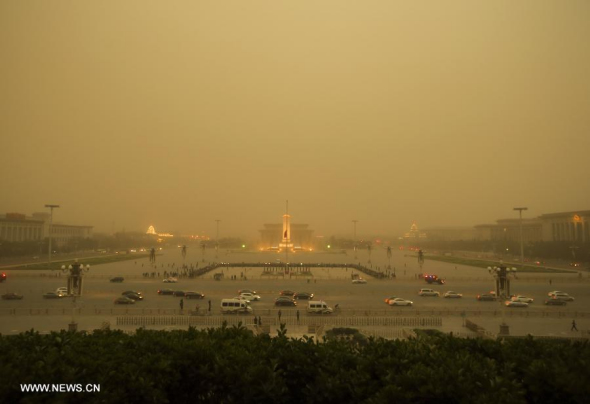
Photo taken on April 15, 2015 shows the Tiananmen Square enveloped in sandstorm in Beijing. Beijing was hit by moderate gale from Wednesday evening to night, and Beijing Meteorological Observatory has issued a yellow alert for sandstorm on Wednesday afternoon. (Photo/Xinhua)
(ECNS) - The Chinese capital Beijing, already plagued by smog, is suffering from another kind of environmental punishment. On April 15, a sandstorm lasted for nearly three days and affected an area of 1.4 million square kilometers, about one-seventh of China's total land area.
"The last time Beijing city proper was hit by a sandstorm was on March 20, 2002," recalled Gui Hailin, a senior engineer with the National Meteorological Center. But this spring the north of China has witnessed seven sandstorms and Beijing has endured three.
Beijing citizens have already long been tortured by smog, and now sandstorms have returned. The question is, how are sandstorms being formed, and why?
Sand source
Gui explained that the sandstorm which hit Beijing on April 15 originated from the cold air from the center of Mongolia. The air moved through the center of Inner Mongolia, an autonomous region of China, and pushed southward to influence Hebei and Shanxi provinces as well as Beijing and Tianjin municipalities.
The nearest source of the sand is the Hunshandak Sandland, one of China's 10 largest deserts, just 180 kilometers from Beijing. Public information shows that this sandland is one of the major sources that has tortured Beijing in the past years.
Parched land
A shepherd from Inner Mongolia insists that grassland degradation is the result of overgrazing. A volunteer devoted to planting trees and desertification control in the Hunshandak Sandland holds the same view.
Some experts agree. Gui said that large areas of grassland and farmland in China have become desertified from overuse and that the topsoil is easily carried away by the wind.
Moreover, many Chinese lakes have been shrinking, becoming additional sources of sand. In farming and animal husbandry areas, the main cause is irrigation. In grasslands, the major reason is coal mining, which consumes large amounts of water.
Slow progress
China initiated forestry protection and restoration projects as early as 1979, reducing sandstorm frequency since then.
The government has also encouraged herdsmen to move to towns and cities in an effort to protect fragile grasslands.
Yet the situation remains dire. Overgrazing is common, as husbandry is the only source of income for herdsmen. Meanwhile, the administration of environmental measures is split between various government departments, resulting in ineffective enforcement, and subsidies for reforestation can not match the rise in the Consumer Price Index.
















































